In June, DC Comics kicked off the start of its Rebirth initiative. After a wave of criticism surrounding the way they have treated their characters’ rich histories since 2011’s New 52 relaunch, DC has decided to rebrand. They hope that by restoring their characters’ pasts, they will restore readers’ faith in them as well. Do they succeed? That’s what the Comics Beat managing editor Alex Lu and entertainment editor Kyle Pinion are here to discuss. Book by book. Panel by panel.
Note: the reviews below contain **spoilers**. If you want a quick, spoiler-free buy/pass recommendation on the comics in question, check out the bottom of the article for our final verdict.
 Green Arrow #12
Green Arrow #12
Writer: Ben Percy
Artist: Otto Schmidt
Letterer: Nate Piekos
Alex Lu: Wow. Hello darkness my old friend. And hello, Otto Schmidt. I missed you.
Over the last several issues, Green Arrow’s structure has diverged from the standard format most DC comics follow. While Ben Percy’s run with the character does have distinguishable arcs, most of these storylines have proven themselves to be more episodic than comparable storylines in other Rebirth titles. However, like CW’s take on Supergirl or The Flash, all of these smaller storylines answer to one major plot that has flowed through this entire run: the destruction of Oliver Queen. In Green Arrow #12, we begin to see the culmination of this major throughline as Queen’s enemies take aim at the very heart of Seattle and Queen’s legacy as the emerald archer.
At this point in Green Arrow, Oliver has lost almost everything and has only just begun to claw his way back from the abyss. Beyond a small group of friends, all he has is his bow and arrow and his reputation. That reputation is the focal point of the “Emerald Outlaw” storyline that begins in this issue. Percy and Schmidt expertly establish the stakes for this arc by showing us Seattle’s divided public opinion on their local hero, presenting us with a news reporter named Victoria Much who surveys a variety of caricatures from around the city. These exaggerated superhero fanboys, punk rock baristas, local cops, and pharmaceutical CEOs paint a vivid albeit comical image of how Green Arrow’s presence has affected Seattle residents in all walks of life. They don’t all support him, but by and large he is seen by the disaffected and underserved as a local force for good.
This, of course, changes by the end of the issue as current Queen Industries CEO Cyrus Broderick launches a new plan to destabilize Oliver’s and Green Arrow’s life, framing him for a series of attacks that take the lives of many of the people interviewed at the beginning of the issue, including Victoria herself. As bookend sequences, these two sequences are effective in raising the stakes for the arc to come. They broaden the scope of what is at stake from the lives of Team Arrow to the lives of everyone in Seattle.
Between these two scenes, though, Green Arrow #12 feels a little hectic thanks to its dedication to a semi-episodic format. We get some check ins on the other major subplots of the series, including a discussion between Oliver and Dinah Lance, the Black Canary, about the current whereabouts of Oliver’s half-sister Emiko and her mother, Shado. We also get a small storyline that aims to comment on the state of policing in America as a ne’er do well policeman shamelessly beats on an innocent man while calling him “filth” as his girlfriend watches and films the beating. We also see Oliver coerce a favor out of a childhood friend who seems like a Trump analog and start a new plotline involving a group of arsonists who burned down a local drug storehouse. While none of the transitions between plots feel jarring in this issue, it certainly does feel like a lot for the story to handle– especially because the need for brevity and compression removes a certain amount of nuance from the political commentary in this title.
I find myself a little nonplussed by the police brutality storyline in Green Arrow #12. While Oliver was certainly justified in ultimately coming to save the man from the cop, the entirely negative light in which the cop was portrayed left no room for debate about the rationale behind his actions. It was a hate crime, plain and simple. Rarely are stories like Eric Garner’s or Philandro Castile’s so black and white, even if the public and the courts ultimately come to the same conclusion Percy and Schmidt do here. The storyline is certainly a feel-good moment for Seattle and the audience, but unfortunately I do not feel like it furthers the discourse surrounding this hot button issue in a meaningful way.
Moreover, I was confused by the nature of and intent behind Oliver’s interaction with local politician Nathan Domini. In the speech that we see Domini give to a crowd of supporters before talking to Oliver, he is painted as something of a Trump analog. His combover and repetitive stream of consciousness rhetorical style indicate as much. However, once he starts talking to Oliver, the mood between the two is oddly civil. There’s some standard left-vs-right banter between Oliver’s attempts to weasel a favor out of Domini, but we don’t see anything that truly explains why Domini was characterized in such a manner.
All in all, while I certainly enjoyed reading Green Arrow #12, I find myself feeling puzzled when I think about the messages behind the storylines here. The issue is certainly effective in establishing an interesting plot for the arc that will follow it and Otto Schmidt’s art is always a welcome sight, but I’m a little nonplussed that the hot-button issues Ben Percy’s script touches upon in this book weren’t explored with greater nuance. How do you feel, Kyle?
Kyle: I’ve been watching a lot of Arrow lately since it’s all on Netflix, and so this issue came at a very good time for me hungering for a fun adventure with Oliver Queen which I think this basically delivers. It, of course, goes without saying that I agree with you that anytime Schmidt is providing art, that’s a highlight in of itself, but I was really happy to see him take on a lot of different environments for Ollie and its cast, be it the bright and sunny Seattle skyline, or the forest setting in which their new base of operations (a treehouse!) is set up, or the fairly rundown Penny Town. Schmidt expertly conveys a mastery of various moods via a perfectly pitched background color swaths within each frame. From the pink and blues that illuminate the police brutality sequence to the deep, blood red that underscores the sense of menace inherent in Broderick. No reader really needs hand-holding in a comic like this, but some attempt at redolant imagery is really appreciated. Plus, I just really like eye-candy. I’m a man of simple tastes in my superhero fiction, ya know?
As for the content inside? It’s a solid start to a “the world is continuing to crash down around our hero” arc. The earliest issues of Percy’s relaunch were highly reminiscent of the seminal Born Again, which remains the go-to standard bearer for heroes rebuilding themselves stories. But despite Ollie finally setting up some level of a life for himself near the city and go-to support team, Black Canary, Diggle, and Henry – continuing his role of being the Felicity of this book (I now associate everything in Arrow terms, I’ve become inundated after all), Broderick has redoubled his efforts to wipe Oliver out, this time not going after his real name…because that’s already gone with everyone thinking he’s dead, but his superhero alter-ego and the public perception therein. It’s a cool plot, the leadup to get there isn’t bad either.
Percy is an interesting writer, as far back as the first issue, he was definitely wearing his political leanings on his sleeve with Green Arrow wearing the “social justice warrior” moniker as a badge of pride. Those progressive concerns have popped up every now and then, though they took a bit of a backseat when the focus was more on Emiko and her conflict with Shado, or even when Ollie and Dinah were fighting their way through that fun high speed underwater train issue. But now that we’re back in Seattle? It’s time to double down on all those real-world issues that’ve been absent. And honestly? I’m okay with it as presented. It’s a blunt look at the violence that occurred throughout our communities, and does indeed lack anything approaching nuance. But this is Oliver Queen, he’s a super liberal hippie with really strongly held convictions about how to accomplish his goals and make his city a safer place to live. He’s a pretty cartoonish character himself, if those that stand directly in opposition to his way of thinking are as well, then I can accept them as blunt instruments to get those ideas across. I mean, I get what you’re saying, and if I was a more right-leaning person, I may indeed take exception to Percy’s approach on the police brutality scene (less so with Domini, who I think he actually humanizes pretty well in his conversation with Oliver), but I think this is, again, Percy’s aim all along: returning Green Arrow to his activist roots. If you don’t have that hard left lean, you end up with something like the beginning of New 52 Green Arrow, and well, nobody really wanted to read that.
This has been a really enjoyable run thus far, and this opening issue to the new arc is no exception. It continues to restore the Green Arrow long-time fans know and love, it has just enough of a hint of the television support team and corporate villain that new fans can hop in and get a bit of something they recognize, and it looks terrific while doing all of that. Give it a shot, it’s not a bad starting place either.
Final Verdict: Buy
 Nightwing #10
Nightwing #10
Writer: Tim Seeley
Artist: Marcus To
Colorist: Chris Sotomayor
Letterer: Carlos M. Mangual
Alex: Thus far, Nightwing has proven itself to be one of the most consistently strong offerings in DC’s Rebirth lineup. A combination of wit, intense action, and complex morality plays have caused it to stand out from the dozens of superhero titles that hit the shelves each week. Most of the previous issues have dealt with the Dick Grayson’s past in the circus, and in Nightwing #10 Tim Seeley and Marcus To re-introduce another element of Nightwing’s history: the city of Bludhaven.
As a newer DC reader, I honestly don’t know much about Bludhaven except for the fact that it was decimated during Infinite Crisis and has a haunting Germanic name. Luckily for readers like myself, in the New 52/Rebirth universe, Bludhaven is new to Dick Grayson too. Seeley and To do an excellent job of establishing the nature of this city to new readers throughout this issue. They do this by framing Dick’s move to the area within a larger re-branding campaign launched by the Bludhaven mayoral office. Tongue-in-cheek slogans like “Get your blud up” and “a scary name for a great place to visit” paint the picture of a tourist-friendly and vibrant area. The casinos and boardwalk as illustrated by To and colorist Chris Sotomayor, highlight this impression. There’s crime in Bludhaven just like there is in Gotham, but as Grayson narrates, there is a “clear line between the haves and have-nots.” It’s the perfect city of “black and white and neon pink” for a hero who’s tired of spending so much time dancing between the lines of good and evil.
However, nothing can be simple for Dick. He’s on a journey to rediscover who he is outside of his tights. He decides to volunteer at a community center and make time for old hobbies. Unfortunately though, he quickly finds himself bored of watching TV and reading comics and discovers that the woman at the community center who hired him has an alter ego of her own. All this on top of a disconcerting encounter with an intelligent gorilla arms smuggler named Gorilla Grimm quickly proves Bludhaven is not as transparent as the brochures imply. The way in which Nightwing’s perceptions of Bludhaven are shaken is not particularly subtle, but it is effective in setting up stakes for the arc that will follow this issue.
Perhaps my greatest criticism of this book is how sparse the artwork feels. While Marcus To does an excellent job illustrating figures throughout the story, his backgrounds are not particularly detailed– if they exist at all. Many of the backgrounds in Nightwing #12 are simply white space. At times, this is just a minor sticking point, but during certain sequences the problem is actively grating. Sotomayor’s shading is somewhat sparse, so when Nightwing’s face is juxtaposed against negative space, he looks absolutely pallid. Scenes set in the evening where Nightwing is swinging over Bludhaven’s neon skyline are rendered much more convincingly and highlight just how much work could have been done on this issue’s art as a whole to elevate it to the next level.
Ultimately, I think Nightwing #10 is a strong start to a new chapter in Dick Grayson’s life, though I wish it were illustrated with more care. What’s your take, Kyle?
Kyle: I agree with you take that Nightwing is one of the more fun titles in the Gotham side of DC’s lineup right now, with recent issues strong enough (the Batman and Superman look-ins were emotionally quite compelling) that it’s vacillating between #2 and #3 overall for me. Seeley just gets this carefree daredevil version of Dick Grayson in a way that so many other writers just really failed to grasp. Dick is fun, and sexy, and smiles a hell of a lot. Of that a core cast of Batman supporting players who tend to grimace or have their lives infected by continuous tragedy, Nightwing is the one who lets the sunshine in a bit. I’m not saying really anything illuminating by pointing that out, but it’s remarkable how many pre-Seeley Nightwing comics didn’t fit that bill. Which brings me to Bludhaven…
I was never big into the Dixon run on the character, and I think generally the less said about the tenures that followed him, the better, but Bludhaven never really left much of an impression on me and anything but “not Gotham”. Maybe some Nightwing superfan can correct me with all kinds of unique tidbits about it, but other than Blockbuster as the criminal mastermind of the area and its being “worse than Gotham”, Bludhaven strikes me as fairly unidentifiable. With that said, this gives Seeley and To an opening to craft up a real personality for this city…which on its face kind of looks like Atlantic City maybe? A bit of a struggling tourist destination that has a vein of organized crime in its history, and a gambling-centered boardwalk makes for a not terribly hard leap towards “America’s Playground”. It’s a good starting point, and that bright neon that is both underlined in the text of the story and in Sotomayor’s colors gives this book even more of a place to stand out in a line that could use further visual differentiation in its various settings.
What I appreciate best about this new start for Nightwing are its quiet moments. I loved the panels of Dick taking time for himself, watching some kind of Game of Thrones knock-off and getting spoiled on it by Roy over the phone. These little dashes of character are so very welcome, as is Nightwing getting to tussle with a gorilla! I also felt like Seeley set up a compelling enough mystery as to what is going on with Shawn and Jimmy at The Haven Community Center, and there’s a nice carry-over between Raptor’s interests in Nightwing’s branding and how the latter may get used to the benefit of the Mayor’s office and their attempts to secure more tourist dollars by having their own superhero.
I do agree with you about the sparseness of the art, and I think a lot of that is the choice of going with flatter colors on Sotomayor’s end, which worked fine with Javier Fernandez, but with Marcus To smoother line and sparser backgrounds in places, creates some trouble spots. I, too, was a bit taken aback by the washed out faces in that office sequence. But, if you can look past those slight trouble spots, this is another solid outing in run that just quietly keeps on keeping on.
Final Verdict: Buy
Round-Up
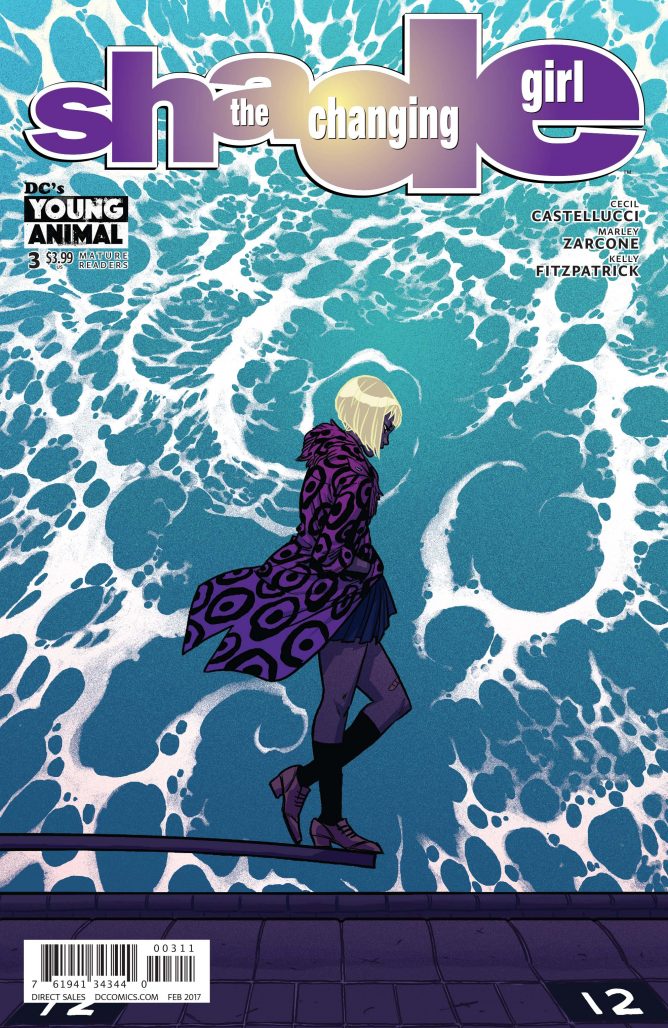
Alex: Indeed indeed, Kyle. You’ve covered most of what was on my mind, though I really have to disagree with you about Batman #12. As much as I, too, would like the “I Am Suicide” arc to reach a climax sooner rather than later, I found my breath taken away by the magnitude of this issue. Mikel Janin outdoes himself again in this issue, filling the book with double page spreads that give him full reign to put his kinetic work on display. While I’m not big on King’s usage of letters between Selina Kyle and Bruce Wayne as a method of narration, I admit that it is effective in establishing a rhythm for the story. That rhythm is the key to what makes Batman #12 work so well. You can hear the repetition of phrases and mantras echoing through your mind as you watch echoes of Batman float through the time lapses Janin uses to establish the Dark Knight’s movement through battle after battle. It’s a verse leading into a chorus leading into a bridge, all leading to one final moment where Batman comes face to face with Bane. This is simply a beautiful single issue and is my definitive pick of the week.
Miss any of our earlier reviews? Check out our full archive!


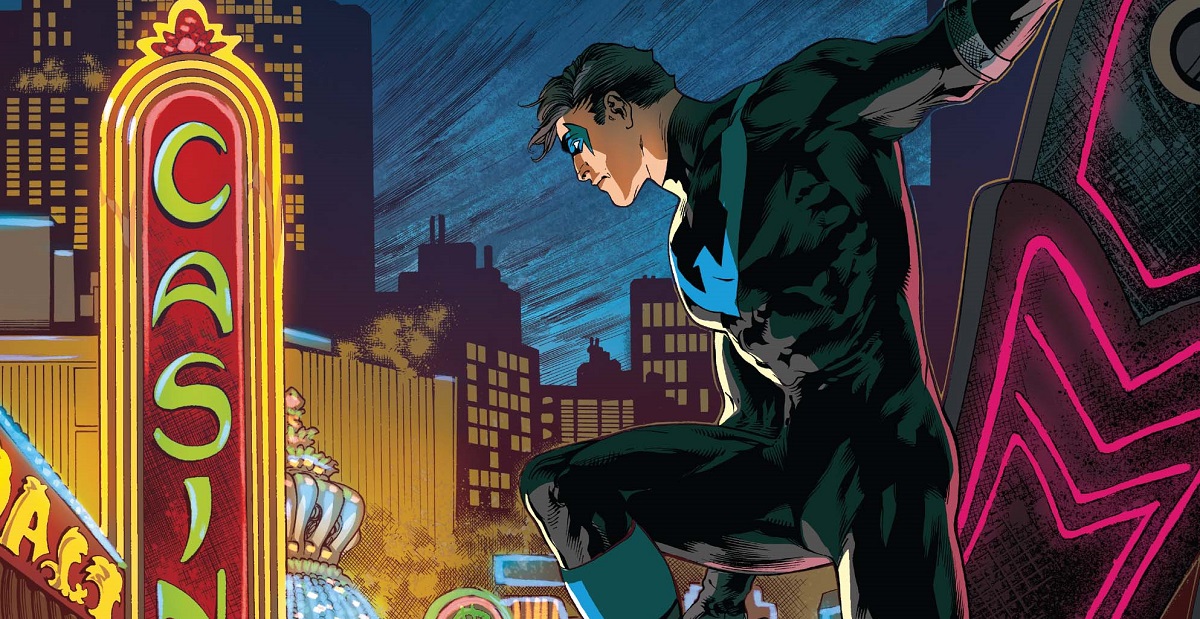
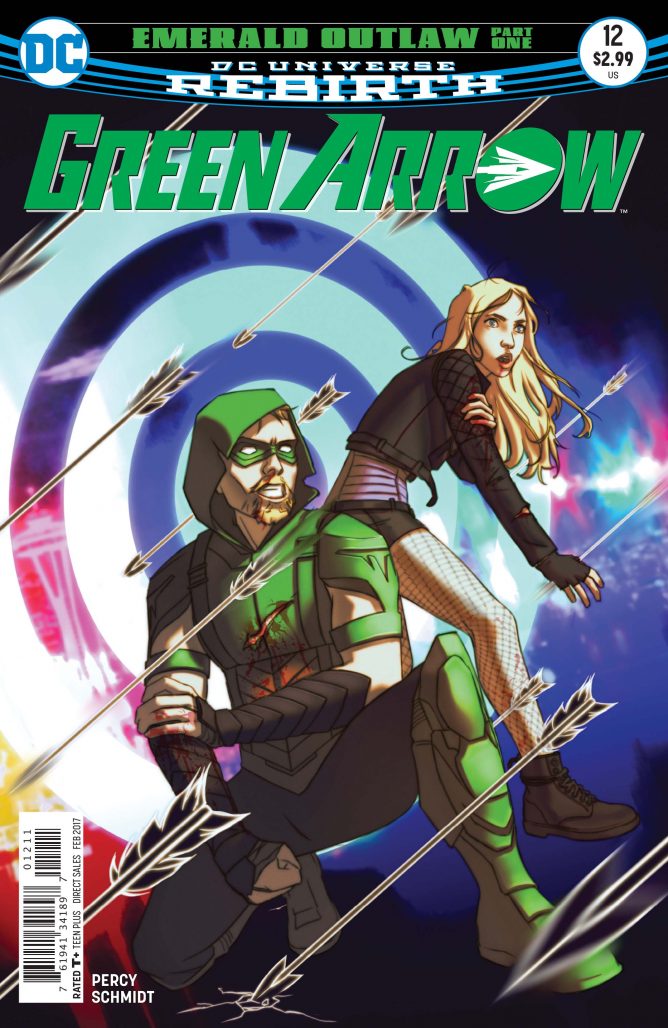
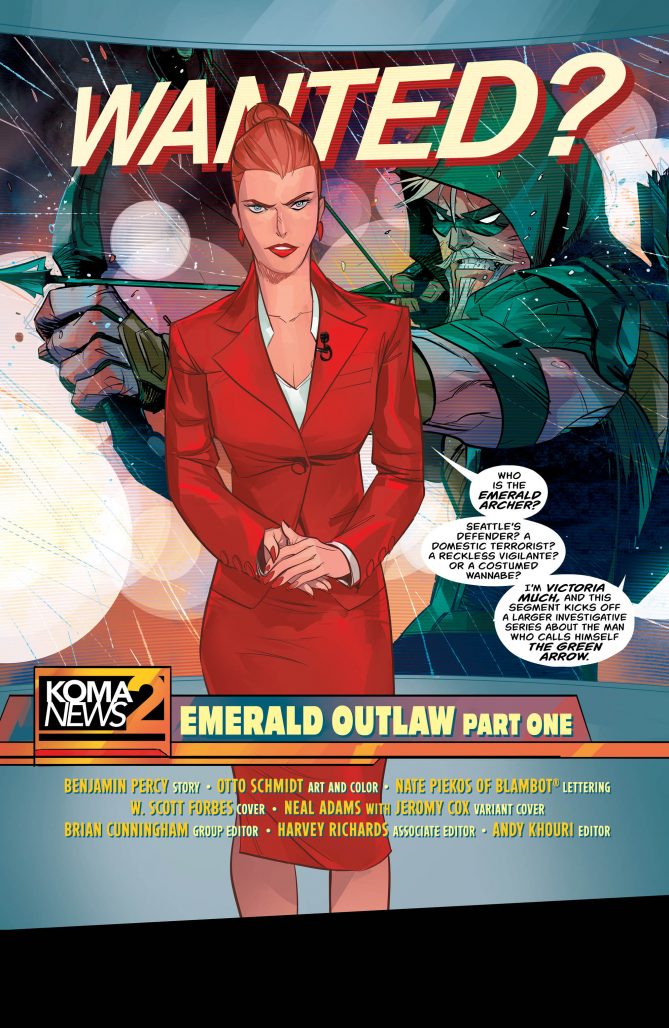
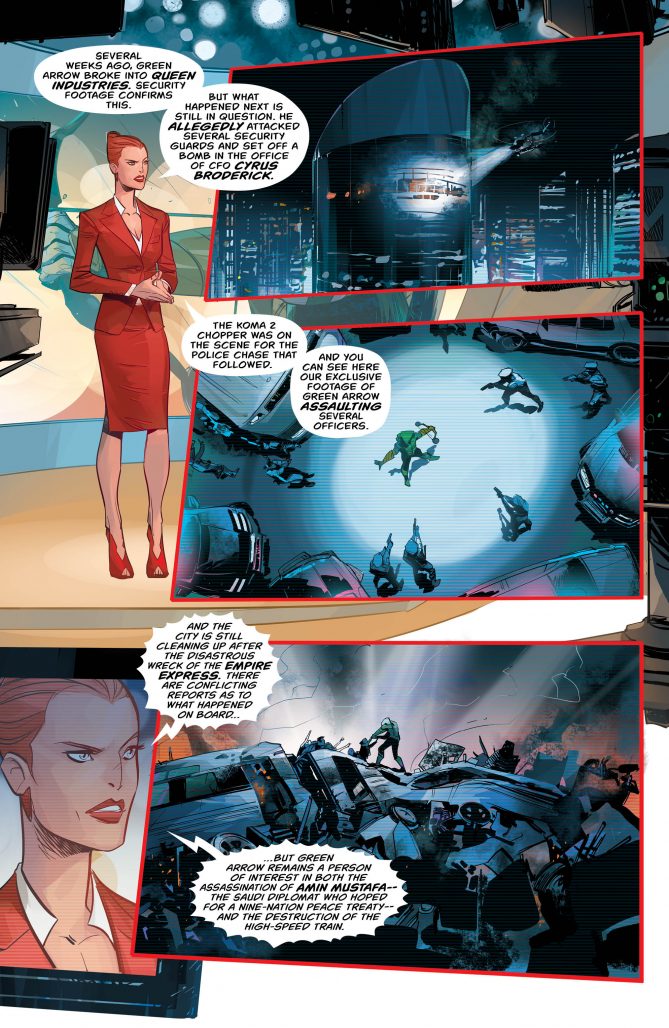
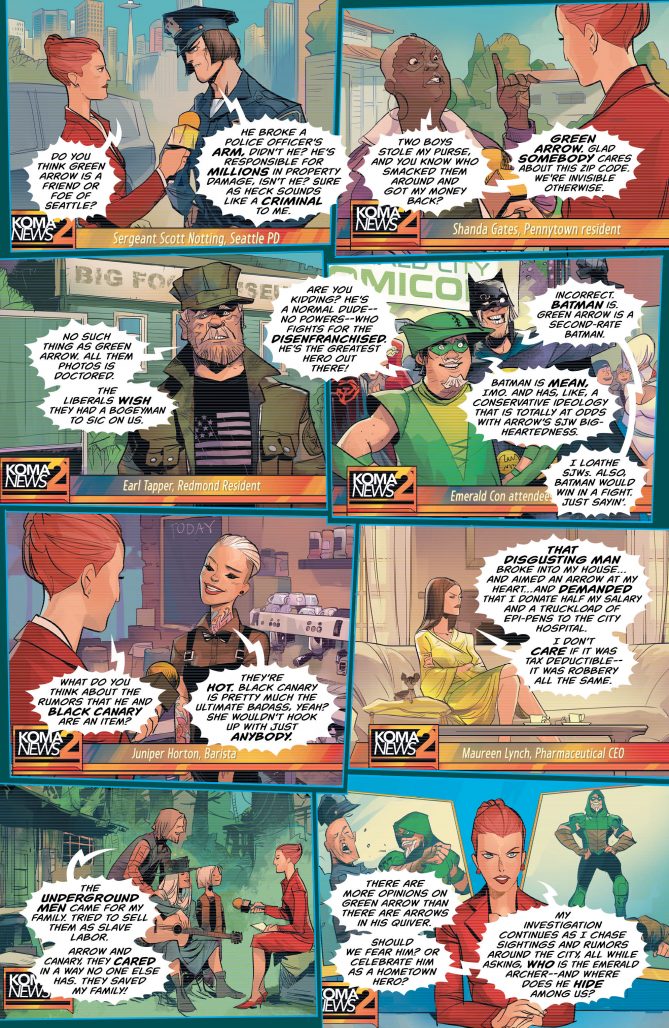
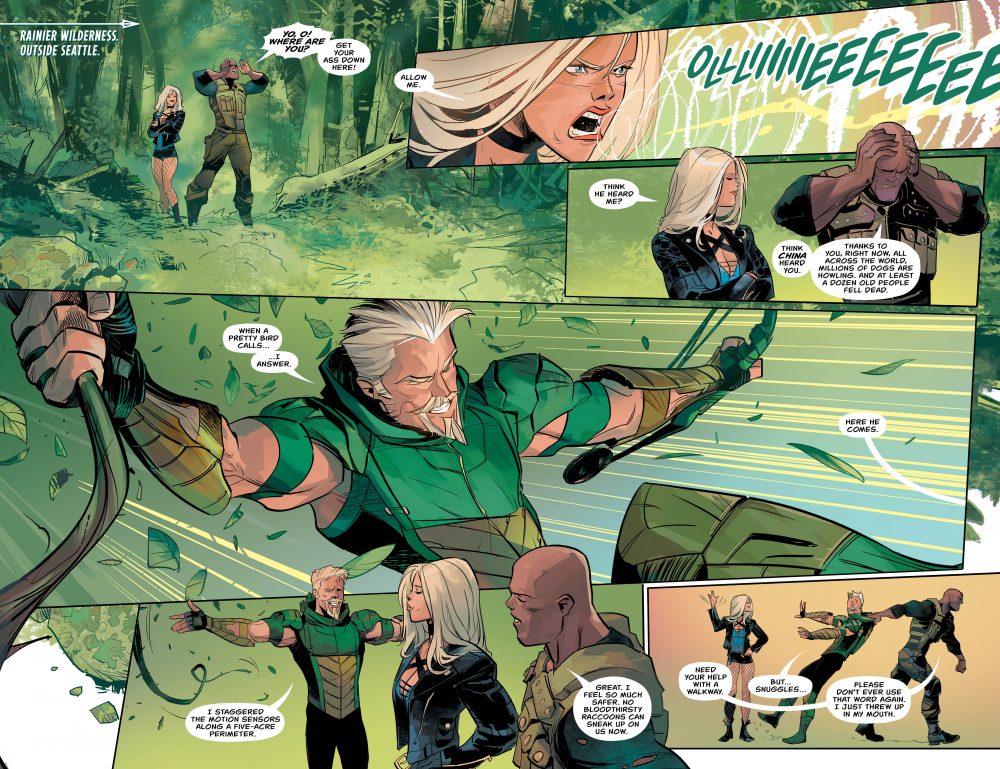
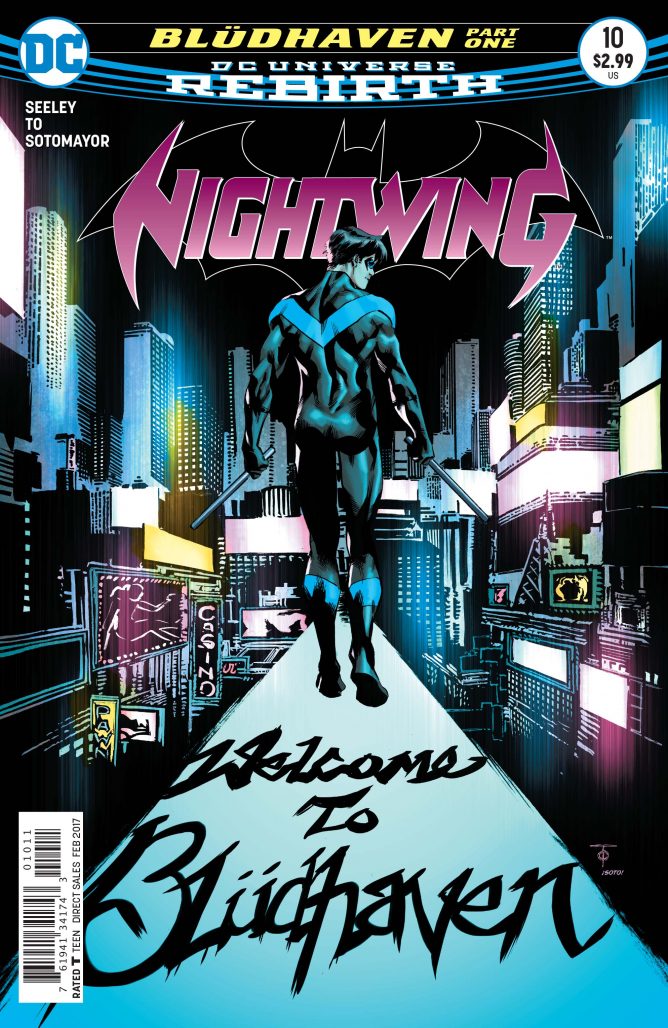
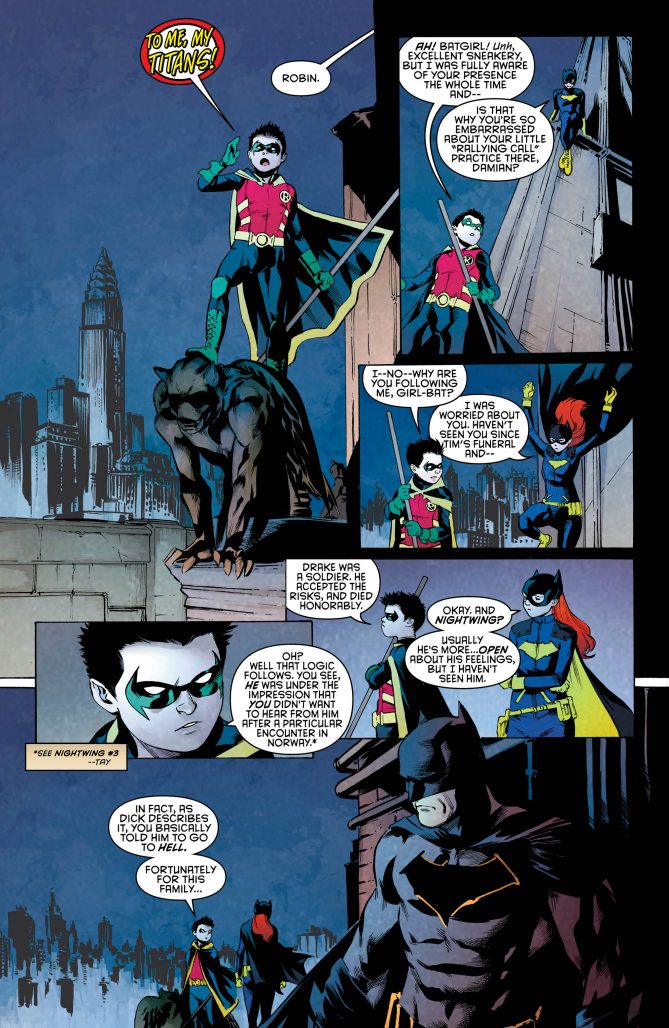
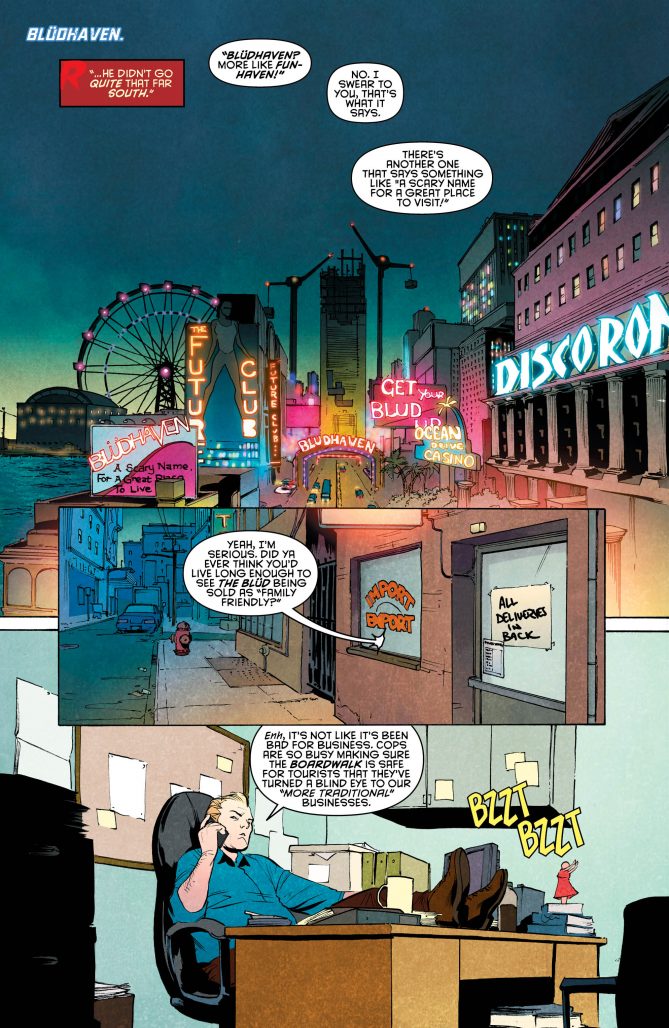
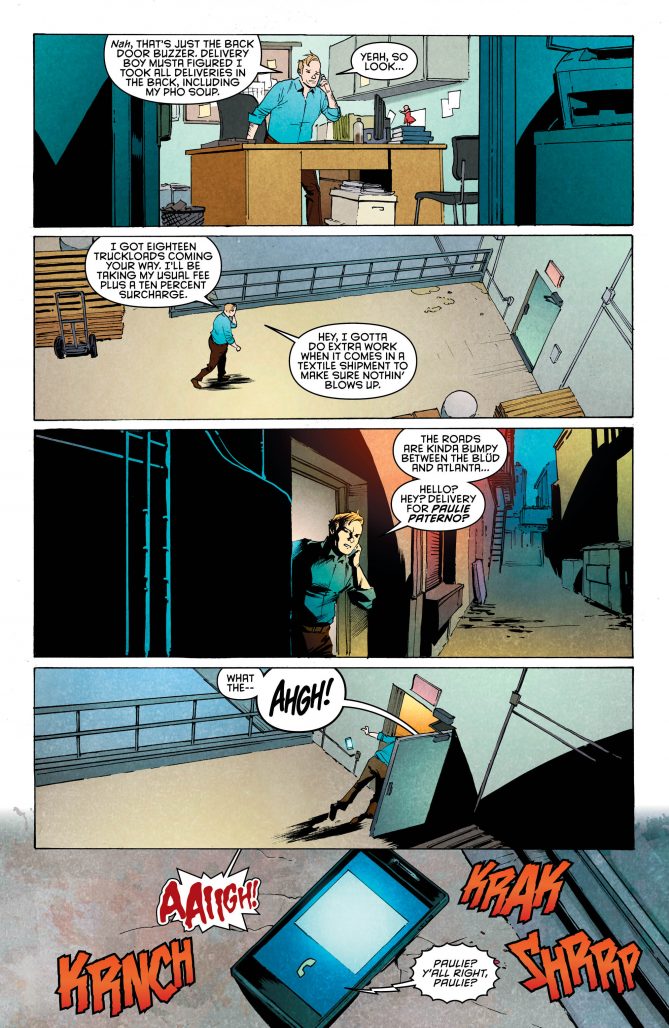
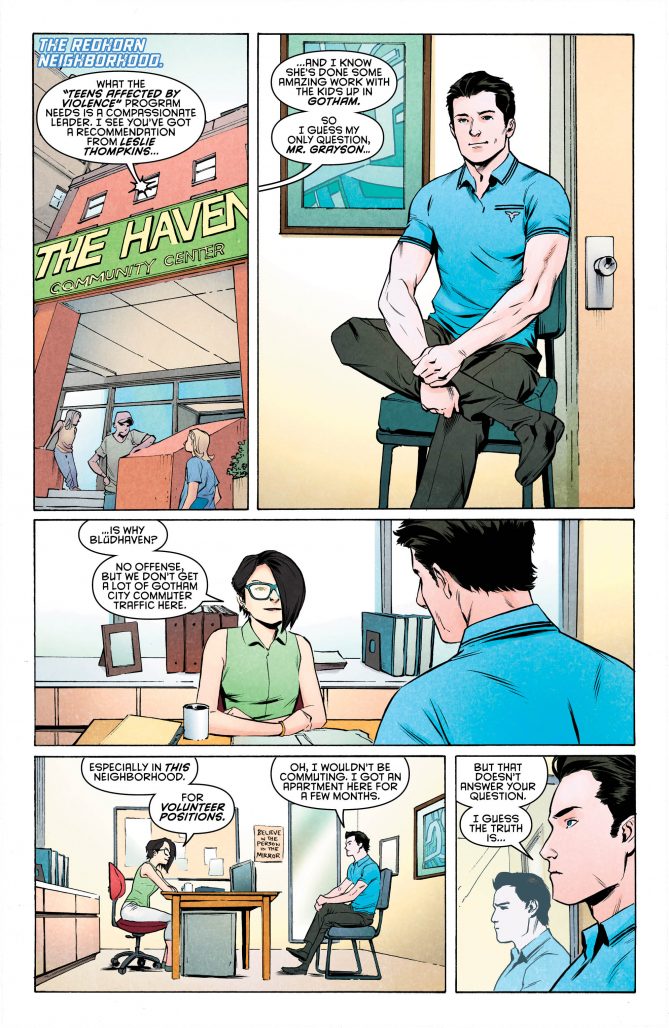
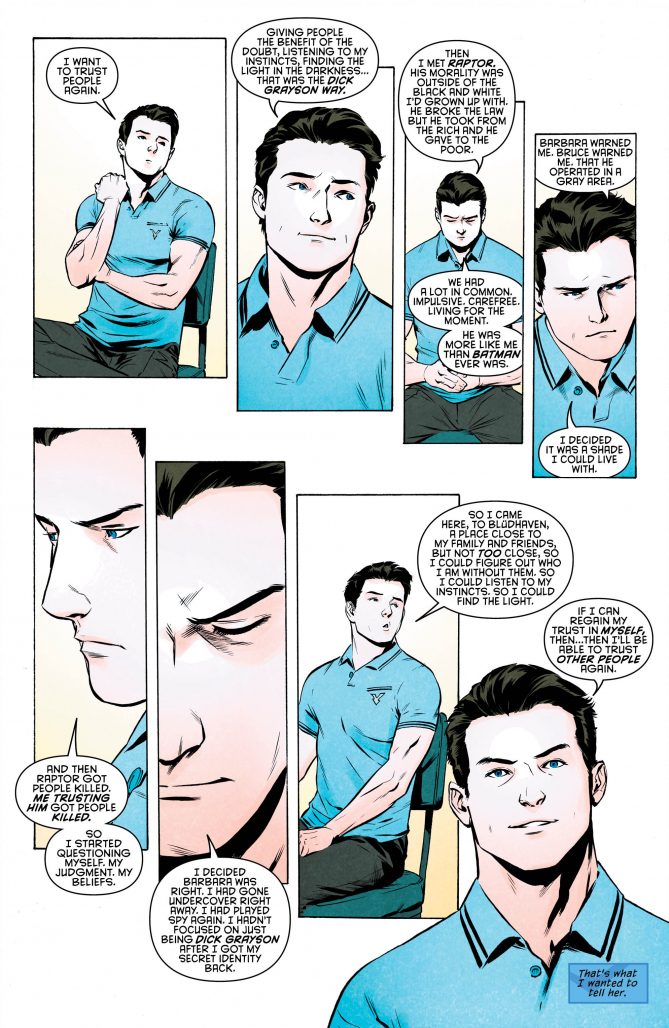
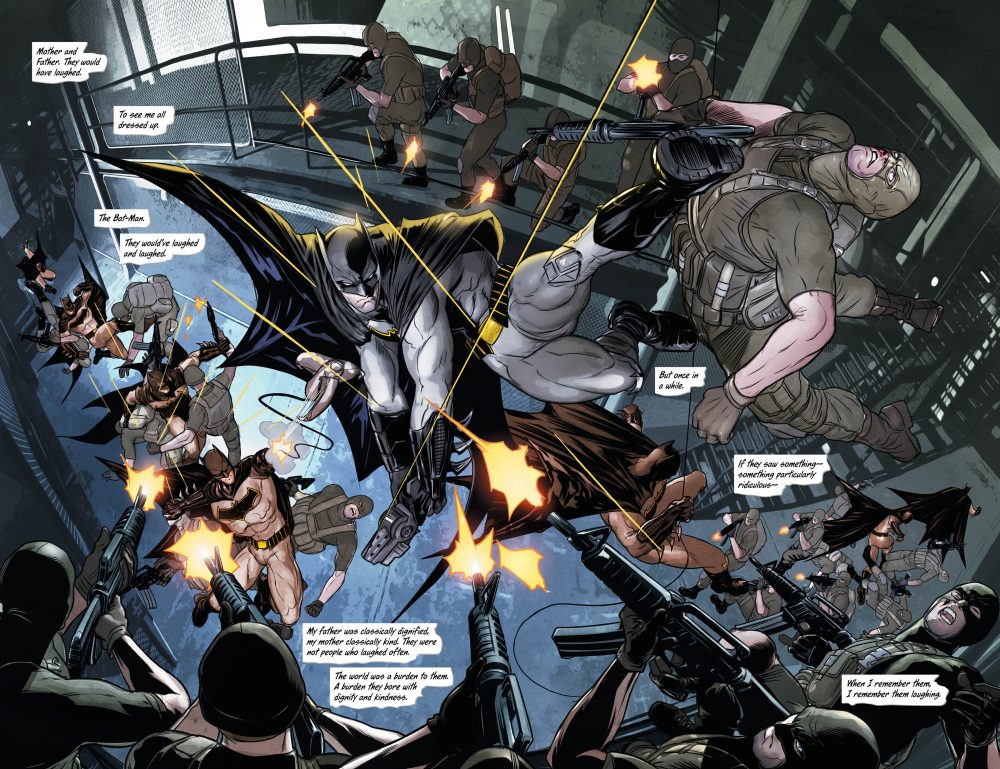






Batman was interesting. Visually, it was an extended action scene, but the story itself was entirely about Bruce coping with his tragedy, and how he saw Selina. This arc definitely feels like something that works better as a trade, as I think everything is building towards a big climax. This book seems to be getting a very divided reaction.
Superman was fun, but it wasn’t my favorite issue of the series. I thought the fight could have been avoided if Frankenstein would have just took a couple of seconds to explain himself.
Nightwing was fun, and I like the ideas Seeley is adding, like the city trying to make itself attractive to tourists, and the ex-villain support group. I wonder if the reason why Defacer was getting into costume was because she was running a “scared straight” program.
Comments are closed.